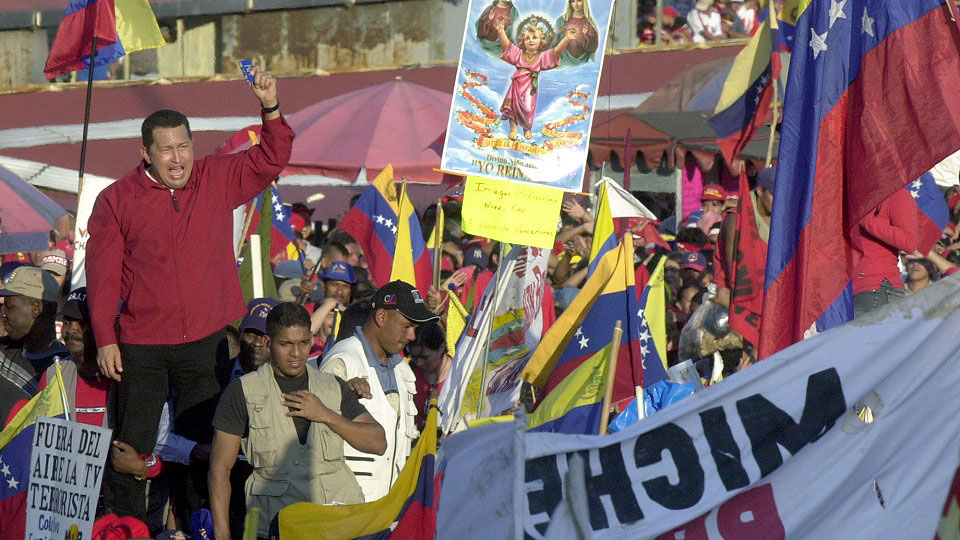
Twenty years ago, at the dawn of the 21st century, a failed U.S.-backed coup in Venezuela, a little-known South American country, set Latin America onto a new course and helped place socialism back onto the global agenda.
With the collapse of the Soviet Union in 1991—an event which free market disciple Francis Fukuyama infamously declared to be “the end of history”—went the last bastion of protection for millions of workers who would subsequently fall prey to the ravages of global free market capitalism.
After two world wars, followed by a three-decade Cold War (really a third world war), the stage was set for what filmmaker Marcelo Arreaza terms the “fourth world war,” one that has been waged by neoliberal globalization and its transnational corporate elite against the oppressed peoples of the world, largely concentrated in the Global South.
NAFTA and other free trade agreements allowed capital to cross borders freely and let a handful of powerful multinational corporations ascend to god-like status over global free trade zones, where they reaped obscene super profits by exploiting cheap labor in Mexico, Haiti, Indonesia, and countless other countries.
Indeed, to create what Vijay Prashad calls the “international division of humanity,” Washington cultivated its powerful financial arms—the International Monetary Fund (IMF) and the World Bank—to induce a debt crisis for the developing world: Between 1970 and 1991, the combined debt of the 15 most heavily indebted countries skyrocketed from $17.9 billion to $1.4 trillion, 126.5% of those countries’ total exports.
To service the debt meant the decimation of social infrastructure for the world’s 37 poorest countries, namely a 50% reduction in per capita education spending and a 25% cut in health spending. According to UNICEF, this neoliberal financial system led to the deaths of some 40,000 children per day. Indeed, the price of capital accumulation in the era of globalization has been increasing misery, hunger, and death for millions in the third world.
U.S. imperialism enforced this unipolar world order at the barrel of a gun. The U.S. empire’s 19th century westward expansionism, prophesied in the Monroe Doctrine, foreshadowed the southward interventionism of the 20th century, a policy which viewed Latin America in particular as the empire’s backyard. In the second half of the 20th century alone, the U.S. backed violent right-wing coups and sometimes direct invasions in nations such as Guatemala, Cuba, Chile, Haiti, and Grenada, and imposed a 60-year criminal blockade against Cuba.
The anti-communist Cold War in the region led to the murders of some 60,000 activists, many of them trade unionists, socialists, and communists. Indeed, the U.S. military-industrial complex, what Dr. Martin Luther King called “the greatest purveyor of violence on earth,” still today encompasses a $728-billion Pentagon budget that eats away at human needs programs here at home.
Venezuela
Perhaps no other Latin American nation better exemplified imperialist underdevelopment than Venezuela, the world’s fourth largest exporter of oil. The oil-dependent nation was plagued by what economists call “Dutch disease”: The black gold of the Earth completely dominated its economy (constituting over 90% of exports), reduced agricultural production to the lowest percentage of GDP in Latin America, and completely stifled the country’s domestic industrial development.
Power was shared by several corrupt political parties who controlled all of the oil wealth that hadn’t gone to foreign firms. When the price of oil dropped in 1979, the country began a traumatic 20-year decline, with poverty and inequality skyrocketing to the highest levels in Latin America.
In 1989, President Carlos Andrés Peréz’s government responded with an IMF structural adjustment package. This triggered the Caracazo—considered by many scholars as the origin of the global rebellion against neoliberalism—where hundreds of thousands rioted in the streets of Caracas to protest the shock treatment of Peréz’s government, whose imposed austerity package had drastically increased the price of transportation, food, and services for millions of the country’s poor overnight.
The military’s brutal repression of the uprising left over 3,000 dead and most of the country’s population still poor. By the end of the 1990s, only 20% of Venezuela’s people were benefitting from the nation’s vast oil wealth, while 80% of the country’s population (17 million people) languished in poverty. It was this political climate that set the stage for Hugo Chávez’s election.
Election of Hugo Chávez
After years of failed neoliberal policies and government repression, Hugo Chávez was elected in a landslide victory in 1998, an unprecedented upset to the country’s old political elites. Chávez, a left-wing member of the military and the first Venezuelan leader to celebrate his African and Indigenous heritage, had run on a social justice platform vowing to combat poverty and redistribute the nation’s vast oil wealth from the elite minority to the poor majority—wealth which, according to Chávez, “had never reached the campesino.”
Once in office, he immediately got to work dismantling the old governing class from power. Chávez called it “the Bolivarian revolution,” inspired by the 19th-century South American independence hero, Simón Bolívar. Pre-figuring the effort underway in Chile today, the Chávez government began with an ambitious campaign to re-write the nation’s constitution based on laws and principles promoting social and economic justice and participatory democracy.
Going far beyond the narrow political liberties of the U.S. constitution, the new constitution established universal health care and education as guaranteed rights for all Venezuelans. It advanced the social, cultural, and political rights of women, Indigenous peoples, workers, and peasants, making it arguably the most radically egalitarian constitution of any democracy on earth.
The Bolivarian government instituted radical land reform to redistribute hundreds of thousands of hectares of idle land to hundreds of thousands of peasants. Chávez began forging an alternative path to the neoliberal order imposed on the continent for decades, and in so doing, he posed a daring challenge to the Washington consensus.
The coup plotters
The straw that broke the camel’s back came in 2001, when Chávez dared to criticize Washington’s bombing of civilians in Afghanistan, openly defying the “with us or against us” logic of the Bush administration’s “War on Terror.” This earned Chávez the full attention of the CIA, which included officials such as Elliot Abrams, Otto Reich, and Charles Shapiro, criminal architects of past imperial ventures in Latin America.
The country was quickly slated to become the next target of U.S. “democratic intervention.” The State Department would now use Venezuela as an experimental laboratory to modernize and fine-tune its tried-and-true regime change formula. No longer would the world’s leading military hegemon need to orchestrate a Pinochet-style overthrow with the brute force of war planes and tanks.
Now the Pentagon could simply manipulate the powerful, privately-owned mass media apparatus, funnel millions of U.S. taxpayer dollars directly to the political opposition, as well as to numerous “pro-democracy” nonprofit organizations like the National Endowment for Democracy and U.S. Aid, which funded and trained the Venezuelan opposition. The objective was to overthrow a democratically-elected president in the name of democracy.
In the days leading up to the coup of April 2002, in the wealthy neighborhoods far from the barrios of Caracas, white Venezuelans of European descent expressed their self-righteous outrage with Chávez in front of eager private media cameras, making unfounded claims that the president was on the verge of turning Venezuela into a Cuban-style communist dictatorship.
Two leaders of the opposition emerged to lead the efforts to overthrow Chávez: Pedro Carmona, president of the Venezuelan Business Association, and Carlos Ortega, president of the CTV, the old guard labor union. These high-ranking coup plotters, backed by powerful owners of private newspapers and television channels, along with the Catholic Church, traveled to Washington several times in to secure the go-ahead from the Bush administration.
Given Washington’s increasing alarm over the radical direction of the Bolivarian government, they didn’t find it hard to get full backing for their illegal conspiracy for regime change that would make the Shaman-man shenanigans of January 6th, 2021, in Washington look like child’s play. Indeed, Goliath had turned his full attention to David.
April 11, 2002
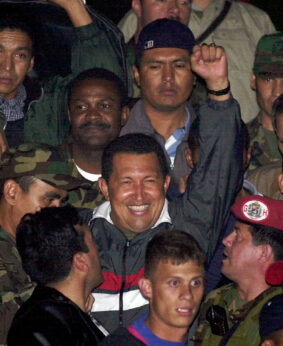
As captured in the groundbreaking documentary—The Revolution Will Not Be Televised— filmed by an incredibly lucky Irish camera crew that happened to be shooting a film on Chávez at the time the coup transpired—the electrifying events of April 11-13, 2002, unfolded like an epic drama.
On April 10, a high-ranking army general appeared on private television, giving what was likely a CIA-written script demanding Chávez give up power lest it be taken from him. The battle cry had been sounded for the president’s forced removal. Carmona then called for a massive march on the state-owned oil company, PDVSA. Unbeknownst to the marchers, however, they were to be part of a bigger plan.
On Thursday, April 11, thousands of opposition demonstrators embarked on their march towards PDVSA. Meanwhile, a growing number of Chavista counter-demonstrators rallied outside of Miraflores palace to show solidarity with the government. Then, suddenly the opposition leaders illegally changed the route of their march, channeling protesters towards the presidential palace, inevitably setting up a confrontation.
The army tried to serve as a buffer to keep the crowds apart when, out of nowhere, hidden snipers opened fire, shooting several demonstrators in the head, killing at least ten people and wounding dozens from both sides. The opposition-controlled media captured Chávez supporters on a nearby bridge firing back towards the sniper fire, but the media manipulated these images to blame Chávez supporters for “assassinating innocent marchers” on the street below.
What the camera angles didn’t show was that the street below had been empty during this shootout: The Chavistas had been exchanging fire with the snipers above, hence why they were continually ducking. While government supporters had not in fact assassinated peaceful marchers, this parroted lie became the trojan horse for the coup conspirators to generate a crisis which had been carefully premeditated.
Right on cue, several senior military officials appeared on television with a pre-written request for Chávez to resign in wake of the “spontaneous uprising.” The army was now split; military units in Fuerte Tiuna who had been called to come to the defense of the president were blocked by the pro-coup elements, who called for his arrest and resignation.
In the early hours of Friday morning, to avoid further bloodshed, Chávez agreed to go peacefully as he was arrested in Miraflores and taken hostage by the coup makers, who would eventually take him to a remote island. While confronting grave risk of assassination, he refused to sign any resignation document.
With the president kidnapped and out of the way, the oligarchy immediately set up a puppet government which was quickly legitimized by the U.S. Carmona was sworn in as the new president; the National Assembly and the Supreme Court were dissolved. The new people’s constitution was abolished. All appeared lost.
Every April 11th has its 13th
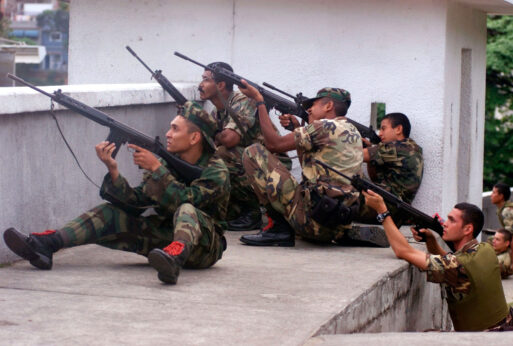
Then, something unprecedented happened. A sea of Chávez supporters rolled down from Caracas’ shantytowns, enveloping the palace and demanding the return of their rightful president. The rank-and-file officers of the President’s Honor Guard, meanwhile, still loyal to Chávez, swooped in to retake control of the palace.
Carmona fled, only to be arrested at Fuerte Tiuna. In the early hours of Sunday morning, the people’s president was greeted by thousands of cheering supporters as he arrived back at Miraflores. The coup had collapsed within 48 hours due to Chávez’s popular support in the ranks of the military and among the popular classes.
It is quite ironic that, for a president that was endlessly maligned as an authoritarian dictator, not a single coup plotter was jailed after Chávez returned to power. Several months after the failed coup, the opposition made a second attempt at destabilizing the government by organizing an oil strike among the state oil workers, with the hope of paralyzing the country. This plot, too, failed.
The revolution goes on the offensive
The counterrevolutionary assault of 2002, repelled by the masses, had backfired. Instead, it strengthened Chávez’s popular mandate to intensify his policies against inequality and the Venezuelan bourgeoisie. Chávez embarked on a path of what he now called “21st century socialism,” a grassroots, participatory socialism from below, rooted in the peasants and indigenous communities, who were to be history’s new protagonists.
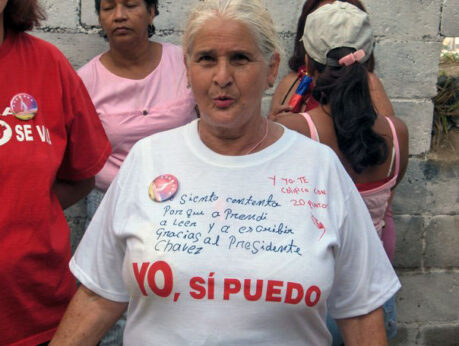
Funded by oil revenues, the government developed revolutionary programs known as social missions, which resulted in transformative gains for millions of poor citizens over the next decade. Within two years, the U.N. declared Venezuela free of illiteracy after 1.5 million low-income Venezuelan adults were taught to read and write through Mision Ribas’ volunteer-run night schools.
After decades of being left in the dark by the oil-rich elite, elderly campesinos were able to participate in the democratic process for the first time. The government built 3,000 new schools, and by 2002, school attendance had jumped by 25% at all levels.
Through the Barrio Adentro (“Inside the Neighborhood”) mission—an initiative that would reach beyond the wildest dreams of Medicare-for-All advocates—15,000 Cuban doctors doctors and health professionals were sent into the barrios of Caracas and poor rural communities to provide millions of free consultations to Venezuelans who had never seen a doctor, thus ensuring their new constitutional right to free healthcare.
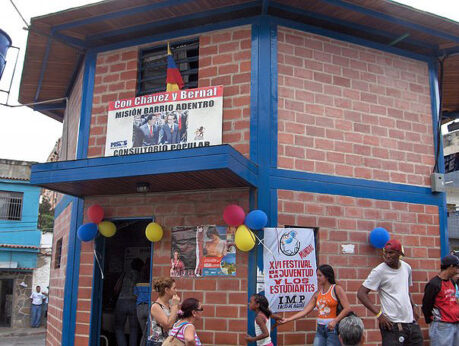
The government constructed over 6,000 community health clinics, along with hundreds of Integral Diagnostic Centers and Rehabilitation Centers, while spending billions to renovate the nation’s hospitals. By 2009, 82% of Venezuelans were using the free healthcare system, infant mortality had been cut in half, and over half a million lives had been saved.
In order to combat hunger, mission MERCAL—a network of over 10,000 public grocery markets that provide high-quality food at low prices—was established to guarantee “nutritional security” to citizens as a right enshrined in the constitution. To combat the country’s colonial legacy—which had left ownership of 70% of arable lands in the hands of just 3% of the population—the state redistributed over two million acres of idle land owned by elites or multinationals to some 200,000 working families.
Additionally, through the most progressive and expansive public housing program in the Americas (Mision Habitat), the Venezuelan government built over 300,000 units of social housing for the poor in 2011 and 2012 alone. By 2010, the Chávez government programs had cut poverty in half along with levels of malnutrition, and extreme poverty was reduced by two-thirds. The country’s Gini coefficient, a measure of inequality, reached one of the lowest levels in Latin America.
Twenty-first century socialism was carried out by ordinary people in tens of thousands of communal councils established by the government to “give power to the poor” and promote grassroots decision-making and participatory democracy. These councils, established throughout Venezuela’s urban and rural areas, are grassroots democratic decision-making bodies consisting of 200-400 families each. They are funded directly by the federal government, bypassing municipal interference and bureaucracy. They elect their own leaders and collectively plan and implement community projects.
South-south solidarity
The revolution’s socialist ideas spread throughout the region. In 2006, Bolivia’s social movements elected Evo Morales, an indigenous coca farmer, as president. Ecuador, Nicaragua, and Brazil all elected leftist presidents who sought to replicate the independent and self-determining stand of Venezuela in their turn against empire and show solidarity with the Bolivarian project.
As an alternative to NAFTA’s freed trade policies, which had devastated the region’s small farmers, Chávez initiated ALBA (the Bolivarian Alternative for the Americas) as an trading system to promote regional integration, cooperation, and solidarity. It encompasses joint cultural, health, and education projects, including Telesur (TV of the South), a continent-wide television channel to break the domination of Northern media propaganda and allow Latin Americans to see themselves through their own eyes.
Caracas became the hub of anti-imperialism and developing world unity, this generation’s Algiers or Havana. It hosted World Social Forums, the World Festival of Youth and Students, and various congresses aimed at addressing the fundamental questions of our time regarding women’s liberation, food sovereignty, peace, and worker power.
Revolution under siege
After reinvigorating the international left and inspiring millions across the globe, the Bolivarian project began to experience catastrophic setbacks. In 2013, the revolution’s beloved leader, having won six elections, died of a rare form of cancer leaving millions of Chavistas in a state of heartbreak and disbelief.
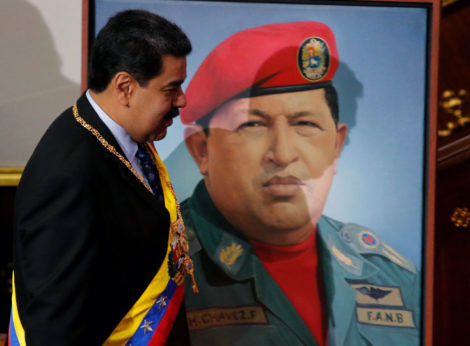
Things only got worse under the government of Chávez’s predecessor, fellow socialist Nicolas Maduro. While the government had made some efforts to diversify the economy, it ultimately could not escape the country’s Dutch-disease: In 2014, when the price of oil dropped from $130 to $30 per barrel, the country was plunged into an economic crisis that has triggered triple digit inflation numbers and led to mass food and medicine shortages, forcing six million Venezuelans to leave their homeland over the last seven years.
All the while, U.S. imperialism’s response to the Venezuelan’s people’s refusal to remain a neo-colony has been nothing short of criminal and barbaric. Washington has prosecuted a two-decade “hybrid war” against the Venezuelan people. This consists of an informational, economic, financial, and para-military war on the country’s sovereignty and right to self-determination.
The newly-gained rights and dignity of Venezuela’s poor were of no interest to the the North American media. Indeed, the New York Times, Washington Post, and CNN—who were silent when Venezuelans were massacred in the street during El Caracazo—now parade as the leading champions of “human rights” in Venezuela, running hundreds of stories to demonize and undermine the country’s socialist government. The media war allows for no nuance or serious understanding of what is happening in Venezuela.
In 2017 and 2019, the Trump administration imposed sweeping sanctions on the already besieged country, exacerbating the economic crisis, blocking access to key food imports, and life-saving medicines. This form of collective punishment has led to the deaths of 40,000 civilians, according to a report by the Center for Economic and Policy Research. The sanctions have only become deadlier in the wake of the COVID-19 pandemic.
In 2019, the Trump administration made another desperate attempt to de-legitimize the re-election of Nicolas Maduro, by formally recognizing the losing opposition leader, Juan Guaido, as the legitimate president of the country. Quite an irony considering that Trump would go on to lose his own election in 2020 while also claiming it was fraudulent and stolen. The U.S. Treasury Department froze $7 billion of PDVSA assets, while the Bank of England stole $2 billion in Venezuelan gold, strangling the country’s economy.
Despite this relentless aggression, the Bolivarian government, and more importantly the Venezuelan grassroots organized in the communal councils, have somehow persevered, partially with help from increased trade with China and Russia.
But the tide may be turning again with the recent election of left-leaning presidents in Bolivia, Honduras, and Chile, governments which are increasingly rejecting the neoliberal model. The current state of Chavismo is certainly precarious and contested, and it is unclear what the future holds for the Bolivarian project.
But there is no question that April 13, 2002, will be remembered as a turning point in the continent’s history, a day when everyday people threw down the gauntlet in the face of imperialist oppression. Let us carry on the fight for a socialist world in the spirit of Chávez. May we respond to every April 11th with an April 13th.






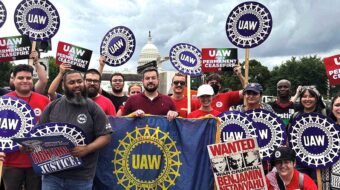





Comments